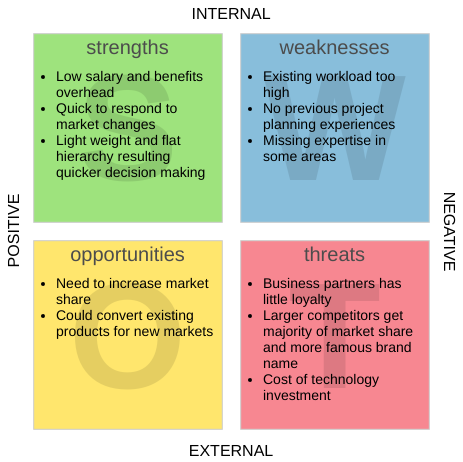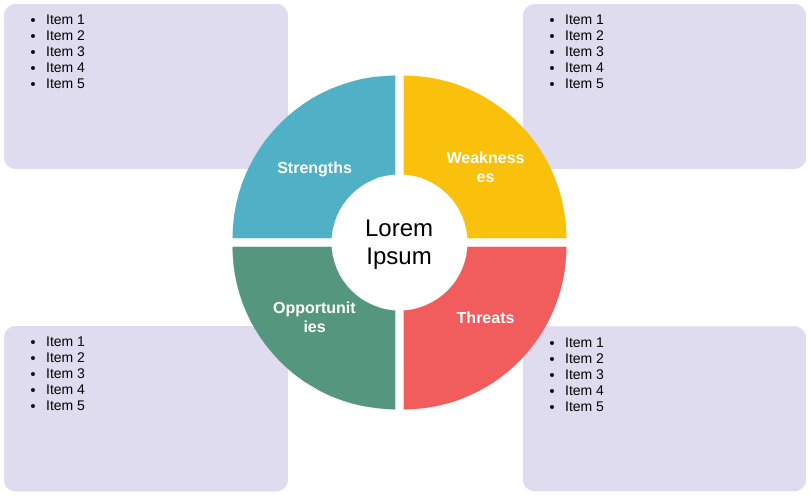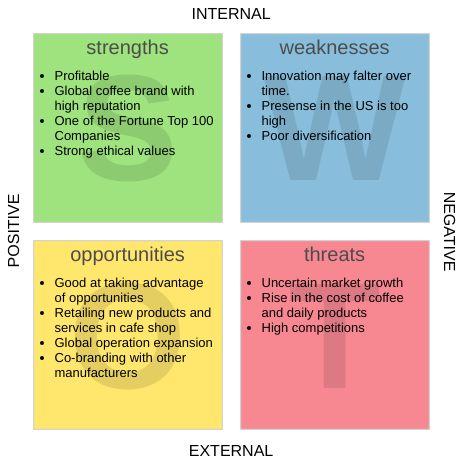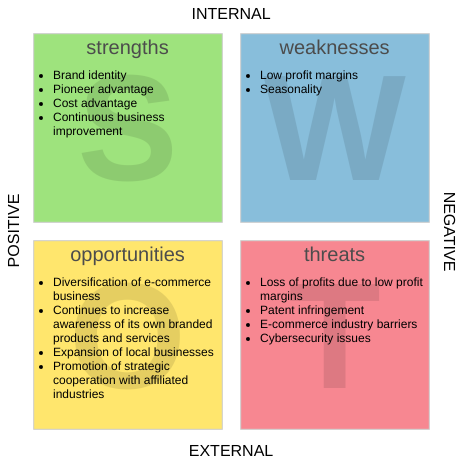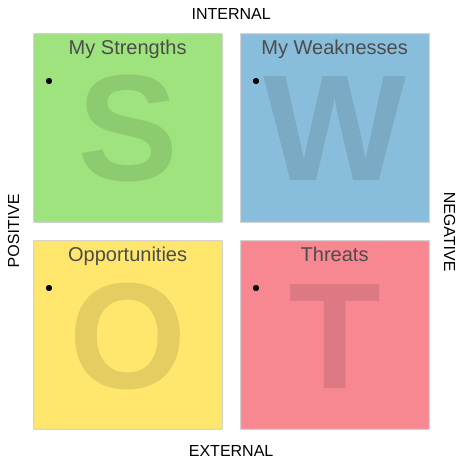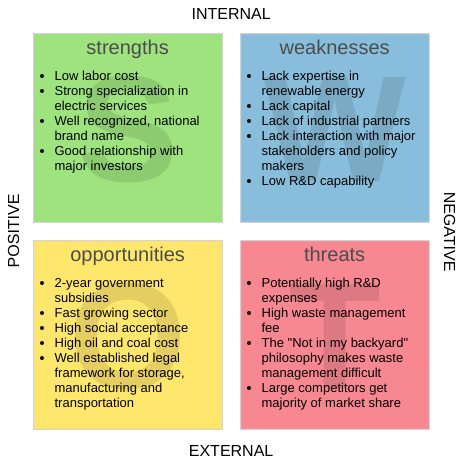Saat mengembangkan strategi pemasaran, SWOT yang paling umum digunakan adalah untuk mengidentifikasi kekuatan dan kelemahan internal, peluang dan ancaman eksternal, dan kemudian merencanakan terobosan strategis. Saat melakukan analisis SWOT, ingatlah empat faktor kunci untuk membantu Anda melakukan analisis yang lengkap dan praktis.
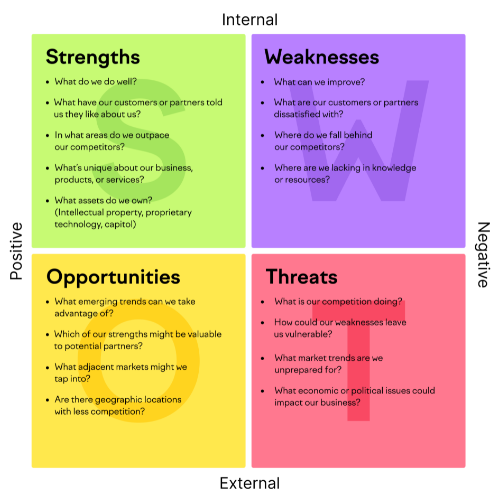
Dari mana asal SWOT?
Pada tahun 1980-an, Heinz Weihrich, seorang profesor manajemen di Universitas San Francisco, mengusulkan analisis SWOT, yang, seperti namanya, terdiri dari empat huruf S, W, O, dan T, yang mewakili Kekuatan, Kelemahan, Peluang, dan Ancaman.
Faktor Internal dan Eksternal SWOT
Kekuatan dan Kelemahan terutama merupakan status “internal” dari bisnis atau produk yang dianalisis, seperti merek yang kuat, basis pelanggan yang loyal, dan teknologi yang unik; namun, harganya relatif tinggi dan perusahaan kekurangan modal.
Peluang dan ancaman adalah keadaan dari lingkungan “eksternal” bisnis atau produk yang dianalisis. Peluang dapat berupa dukungan untuk regulasi baru, hubungan baik dengan pemasok, dukungan kredit bank, dll. Ancaman dapat berupa keterlambatan pembayaran dari penjual, pesaing yang membentuk aliansi, dan perlambatan pertumbuhan pasar.
Kapan melakukan SWOT?
Kapan waktu yang baik untuk melakukan analisis SWOT? Ada banyak jawaban.
- Ini bisa dilakukan setiap musim, sebelum setiap pengembangan produk baru,
- ketika sebuah perusahaan mempertimbangkan transformasi, atau
- ketika ingin mengubah rencananya selama pelaksanaan proyek.
Ini banyak digunakan dalam kombinasi aplikasi seperti mengembangkan strategi perusahaan, memfokuskan sumber daya, memperkuat kekuatan produk sendiri dan mengkompensasi kelemahan, sambil menggunakan kekuatan internal untuk mempertahankan diri dari ancaman eksternal, dan memanfaatkan peluang eksternal untuk menghilangkan kelemahan internal.
Bagaimana Melakukan Analisis SWOT
Analisis SWOT yang khas adalah matriks dengan empat kuadran yang mencantumkan pengaruh relevan yang mewakili empat huruf SWOT.
Identifikasi Kekuatan dan Kelemahan
Saat mencantumkan kekuatan dan kelemahan, faktor internal harus dipertimbangkan secara keseluruhan, mencakup area berikut: sumber daya keuangan (modal, sumber pendapatan, peluang investasi), sumber daya fisik (lokasi, fasilitas, peralatan), sumber daya manusia (karyawan, relawan, audiens target), akses ke sumber daya alam, merek dagang, paten dan hak cipta, serta proses saat ini (program karyawan, hierarki departemen, sistem perangkat lunak).
Saat mengidentifikasi faktor internal: kekuatan dan kelemahan, Anda dapat bertanya pada diri sendiri pertanyaan berikut dari perspektif yang disebutkan di atas:
Kekuatan:
- Apa keahlian atau fitur perusahaan yang tidak dimiliki oleh pesaing?
- Produk/ bidang apa yang dikenal perusahaan?
- Sumber daya apa yang dimiliki perusahaan?
- Apa yang dapat dilakukan perusahaan yang tidak dapat dilakukan orang lain atau dilakukan lebih baik daripada yang lain?
Kelemahan
- Apa yang tidak dikenal perusahaan?
- Di bidang apa perusahaan memiliki sumber daya yang lebih sedikit?
- Apa yang kurang mampu dilakukan perusahaan?
Saat mengidentifikasi faktor eksternal: peluang dan ancaman, Anda dapat bertanya pada diri sendiri pertanyaan berikut:
Peluang
- Di mana Anda dapat menerapkan kekuatan Anda?
- Bagaimana pelanggan Anda dan kebutuhan mereka berubah?
- Bagaimana teknologi mengubah bisnis Anda?
- Apakah ada pasar baru untuk kekuatan Anda? (misalnya luar negeri)
- Apakah ada cara baru untuk memproduksi produk Anda?
- Apakah pelanggan pesaing Anda tidak puas?
Ancaman
- Apakah pelanggan dapat memenuhi kebutuhan mereka dengan produk alternatif?
- Apakah kebutuhan pelanggan berubah dari produk Anda?
- Apa yang sedang dikembangkan oleh pesaing Anda?
- Apakah pesaing Anda meningkatkan penawaran produk atau harga mereka?
- Apakah teknologi baru membuat produk Anda menjadi usang?
- Apakah posisi arus kas dan utang Anda sehat?
- Apakah karyawan Anda puas?
- Apakah perputaran tinggi?
- Apakah kompetisi baru akan datang?
- Apakah penjualan tumbuh lebih lambat dari rata-rata industri?
Bagaimana cara melakukan analisis SWOT?
Seperti yang telah kami sebutkan sebelumnya, SWOT mengacu pada Kekuatan, Kelemahan, Peluang, dan Ancaman. Ini adalah cara untuk merangkum situasi terkini perusahaan Anda dan membantu mengembangkan rencana untuk masa depan. Apakah Anda atau tim Anda merencanakan masa depan untuk produk, pekerjaan, orang, atau area lainnya, Anda dapat melakukan proses analisis SWOT dengan mengikuti langkah-langkah ini.
- Buatlah daftar semua kekuatan yang ada saat ini. Kemudian, secara bergiliran, daftar semua kelemahan yang ada sekarang.
- Daftarkan semua peluang yang ada di masa depan. Peluang adalah kekuatan potensial di masa depan. Kemudian, secara bergiliran, daftar semua ancaman yang ada di masa depan. Ancaman adalah kelemahan potensial di masa depan.
- Rencana Aksi – Tinjau matriks SWOT Anda dengan tujuan mengembangkan rencana aksi untuk menangani masing-masing dari empat area tersebut.
Kembangkan rencana aksi
Ketika Anda menggunakan analisis SWOT untuk perencanaan, Anda menyelaraskan hal-hal positif untuk membantu memanfaatkan peluang dan mengidentifikasi celah dalam hal-hal negatif yang harus diperbaiki atau dikelola. Mendapatkan wawasan dari analisis SWOT memerlukan lompatan strategis untuk melihat hubungan antara kategori (misalnya, di mana kekuatan dapat membantu kita mengurangi ancaman), serta melihat tren secara keseluruhan.
- Kekuatan – Menjaga biaya tetap rendah dengan mengubah struktur kompensasi untuk menyeimbangkan gaji pokok dan bonus berbasis kinerja.
- Kelemahan – Mempelajari, meneliti, dan menerapkan sistem perencanaan proyek serta mengikuti sistem tersebut.
- Peluang – Menguji pasar baru dengan satu produk yang sudah ada terlebih dahulu
- Ancaman – Mengajak mitra bisnis ke dalam rencana komisi berbasis kinerja
Bagaimana cara menggunakan hasil SWOT?
- Kekuatan perlu dipertahankan, dibangun, atau dimanfaatkan.
- Kelemahan perlu diperbaiki atau dihentikan.
- Peluang perlu diprioritaskan dan dioptimalkan.
- Ancaman perlu dilawan atau diminimalkan.
Butuh perangkat lunak analisis SWOT online gratis?
Memperkenalkan Visual Paradigm Online Edisi Gratis, perangkat lunak pemetaan online gratis yang menyediakan alat analisis SWOT untuk analisis strategis yang efektif. Perangkat lunak analisis SWOT ini memungkinkan Anda untuk membuat matriks SWOT profesional dengan cepat dan mudah. Sebagai alat analisis SWOT berbasis web, VP Online berjalan di web dan kompatibel dengan semua browser.
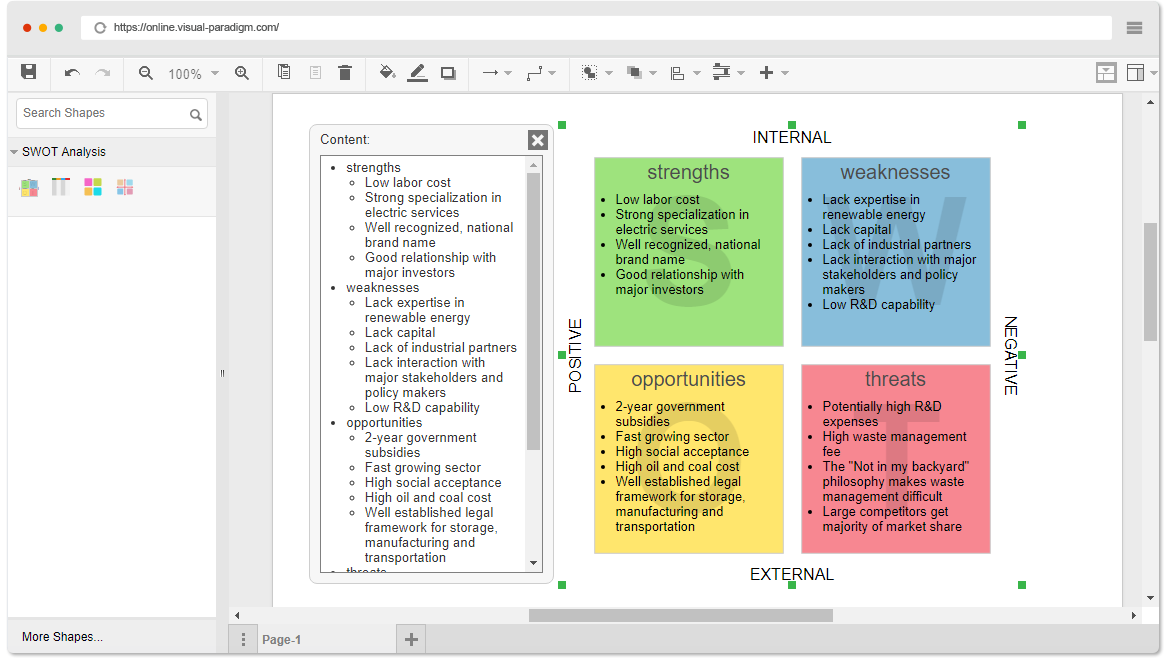
Contoh dan Template SWOT
Template Analisis SWOT (Heksagon)
This post is also available in Deutsch, English, Español, فارسی, Français, 日本語, Polski, Portuguese, Ру́сский, Việt Nam, 简体中文 and 繁體中文.














